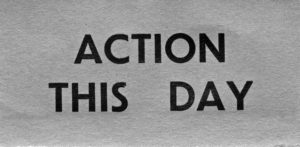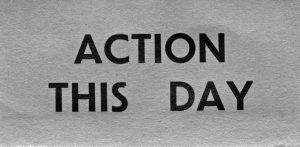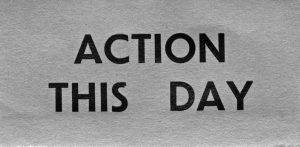Finest Hour 171
Books, Arts & Curiosities – What More Do We Know Now?

Winston Churchill, Parliament Square, London © Sue Lowry & Magellan PR
March 20, 2016
Finest Hour 171, Winter 2016
Page 37
Review by Raymond Callahan
Martin Gilbert, ed., The Churchill Documents, volume 17: Testing Times, 1942, Hillsdale College Press, 2014, 1652 pages, $60.
ISBN 978-0916308469
Martin Gilbert and Larry Arnn, eds., The Churchill Documents, volume 18: One Continent Redeemed, January –August 1943, Hillsdale College Press, 2015, 2471 pages, $60.
ISBN 978-0916308339
When Sir Martin Gilbert died, the monument to Winston Churchill of which he was both architect and craftsman was left incomplete. Larry Arnn, who worked with Gilbert, and who now serves as president of Hillsdale College, picked up the blueprint and tools and is carrying the project forward.
But is the project still necessary? After all, Churchill’s papers have now been digitized, and online access to many other relevant collections is increasing. Researchers are becoming more accustomed to working online than visiting archives, which is time-consuming and expensive. While not all will agree, I continue to endorse the holding of these volumes in hand (or, given their bulk, resting them on the lap) and reading through them (despite some problems with the format).
When Churchill’s war memoirs appeared, the numerous minutes included were likened to listening to one side of a telephone conversation. Churchill’s defense was that he did not have the right to print the responses, most of which were then closed to research. Many critics faulted Martin Gilbert for giving readers the same Churchill-only perspective when material that had become available could have provided a more rounded presentation.
Both in Churchill’s own war memoirs and in the relevant volumes of Gilbert’s official biography (and the accompanying documents), we learn with what queries and rebukes Churchill showered allies, colleagues, and whole Whitehall departments, but we are (unless it is deducible from Churchill’s text) left ignorant of context: what he was responding to—and what those allies and colleagues said in reply.
A. J. P. Taylor once remarked that the British official historians’ convention of applying anonymity to virtually everyone but Churchill left the “perhaps erroneous” impression that the Prime Minister ran the war all by himself. Gilbert did much the same thing. The new editor is clearly aware of this problem because footnotes explain in many cases what triggered a particular prime ministerial note or minute, and some replies are included. Of course meeting the criticism of one-sidedness fully would involve the impossible task of publishing thousands of other documents, but Arnn’s attempt to give readers adequate context is very welcome, particularly since many who dip into these volumes will not visit the archives necessary to tease out the thread of a particular argument.
But if these volumes have and will continue to have some drawbacks from the point of view of historians, they are undeniably of great value to anyone interested in the remarkable man who generated this mass of documents. Paging through the documents gives one the sense of being there—a fly on the wall—as Churchill coped first with the run of disasters in 1942 and then with the equally great, if quite different, issues that presented themselves when the tide turned late in the year and success began to crown Anglo-American endeavors in 1943. How to stop Germany and Japan was central to 1942; how to cope with mounting American power and growing Russian success dominated 1943 (and doubtless for the volumes yet to come). The vision, energy, determination, and willfulness of the Prime Minister are on abundant display, as are his techniques for managing political colleagues, allies, and military commanders. Lurking in the background to this flow of exhortation, critique, and sharply targeted questioning is something that is nowhere made explicit but whose influences are everywhere evident: the work of his personal staff, whose efforts made Churchill so effective.
At the Admiralty during the opening months of the First World War, Churchill had suffered from the failings of the Naval War Staff, then only a few years old (and in fact forced upon the reluctant admirals by Churchill himself on the eve of the war). He had learned, painfully, that the indispensable link between the formulation of policy and its implementation was good staff work. Churchill intended to see that such a link was forged in the Second World War and therefore made himself Minister of Defense in May 1940. Commandeering three very talented staff officers (Hastings Ismay, Ian Jacob, and Leslie Hollis), he created a “handling machine” that tirelessly turned his stream of ideas, commands, adjurations, and rebukes into effective bureaucratic action. Creating this machine was one of his more important actions—and one of the least commented upon.
Reading through documents on subjects ranging from Britain’s precarious import position, to the Second Front, to egg production, the question forms: how did he keep track of it all? The answer is he did not have to. Ismay, Jacob, and Hollis, aided by a small staff of able assistants, did so, seeing that not only did Churchill’s communications reach all relevant departments but that those departments responded in a full and timely fashion. Perhaps only in perusing a massive documentary collection like this does the full scope of Churchill’s accomplish- ments—and that of his trusted staff officers—become fully apparent.
Also apparent: the British Empire was waging a global war, but Great Britain’s war was Atlantic and European, and it is this war that arrested Churchill’s attention. It is striking how little the war “East of Suez” figures in these massive volumes. In August–September 1942, the largest revolt against the Raj since the 1857 Sepoy Mutiny, sparked off by Gandhi’s “Quit India” movement, swept across northern India. Churchill’s preoccupations during those months, however, were with stopping Rommel’s drive on the Nile delta, the reorganization of the high command in Cairo to bring victory out of defeat, and his epic journey to Moscow for his first meeting with Stalin. All of this is extensively documented. There are, however, only stray references to the event that began the ringing down of the curtain on the Raj—to whose preservation, of course, Churchill was passionately dedicated.
In 1943 a famine gripped the province of Bengal in eastern India (now divided between India and Bangladesh). The death toll was about one million. An Indian author has recently accused Churchill of being largely responsible for the famine by deliberately neglecting the mounting food problems in the province. Historians have largely discounted this charge, correctly stressing the multiple causes that, interlocking under the pressure of war, led to the catastrophe. Reading through these thousands of documents it becomes plain that far from deliberately ignoring the deepening disaster in Bengal, Churchill was barely paying attention to any Indian issues in 1942 and 1943. His focus on preserving the bare minimum of food and raw material imports into Britain, in the face of heavy shipping losses in the Atlantic and the necessary diversion of tonnage to support offensive operations, limited the tonnage available to increase grain shipments to India—to that extent, and no further, can he be held to have been a factor in the calamity. It was a brutal choice, but wars usually compel such choices, especially the one Churchill waged.
As time lengthens out, Churchill seems more, not less, remarkable. Only by immersing oneself in his day-to-day workload—which these weighty volumes allow—does it become possible to grasp the titanic burden he bore and the astounding effort he wrung from Britain and its empire. This, in our digital age, is their real justification.
Raymond A. Callahan is Professor Emeritus of History at the University of Delaware.
Subscribe
WANT MORE?
Get the Churchill Bulletin delivered to your inbox once a month.






